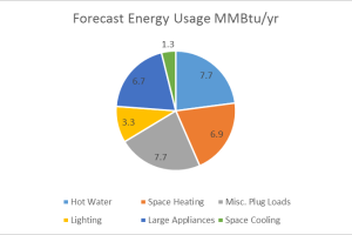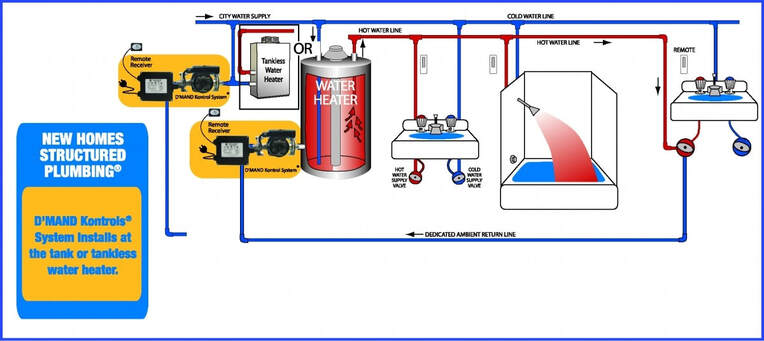 Because hot water is such a big part of our overall energy load, we designed our plumbing system to minimize the energy required for our every-day uses. We purposely located several hot water usage points in close proximity. We located the water heater next to two heavily used bathrooms so that they will get instantaneous hot water (due to a very short plumbing run). And we are sizing our PEX water lines to be of minimum diameter to reduce the amount of water that must be heated to fill up the lines, while still producing sufficient flow for comfort. We will install those lines under the floor instead of in the attic to minimize the length of the runs, thereby reducing the overall amount of water that must be heated. We are also insulating the hot water lines to minimize heat loss. Some of our hardest decisions, however, were focused on how to heat and efficiently distribute the hot water. I. Heating It We were raised to be skeptical when you’re told something’s far better than what’s always worked well. Such is the tank versus tankless water heater question to us. The manufacturers trumpeted the infinite superiority of tankless water heaters and their inherent green-ness without much backup. The California Energy Code automatically docked tankless water heaters 8% of their efficiency ratings, which seemed like further proof that they were over-promising. And when we went to explore replacing our tank unit at our last house with a tankless, we discovered we’d need to upgrade the gas line to provide sufficient fuel for the big burns they use. Experts told us that you’d need a big family that uses lots of hot water to justify the expense of a tankless unit. So when it came to designing the hot water system for our net-zero house, we went in with an open mind. Our tank water heater always seemed to work well, and our gas bills were never very high. We were shocked when the energy models predicted tankless water heaters would seriously outperform tanked models. Here is what we found: Hot water represents 23% of forecast total energy use in our new house, more than space heating and cooling. So the tankless water heater found a place in our new home. There seem to be many well-respected brands out there, including Noritz, Rinnai, Takagi, A.O. Smith, and Navien. Just like our last house, we will need to upgrade the gas line to provide sufficient flow to the unit. And we’ll install it outside to keep the noise level manageable; we hear they can be loud when on full burn.  Here's what the energy models predict our home energy usage will be by system Here's what the energy models predict our home energy usage will be by system II. Distributing It Both tank and tankless water heaters have distribution challenges. One of the challenges we heard about with tankless water heaters is the hot water sandwich, in which the flow of hot water is interrupted by cold water in the lines. The big challenge with tanks is the wasted water that goes down the drain while waiting for the hot water to arrive. We went several months bucketing this water and carrying it downstairs to the landscaping in our old house, until the bucket handle broke on the stairs one day and caused a big mess. But one of our daughters is so sensitive to water waste from her guilt-laced lessons in elementary school that she gets genuinely upset at the sight of water running down the drain. She also thinks baths are water-efficient, but we haven’t burst that bubble for her yet… Anyway, there is a proven technology for managing these hot water delivery issues, the hot water recirculation pump. We are going to install the D’MAND system in our house, which fills the hot water delivery lines with hot water prior to turning on the water in the shower or sink. The unit uses only 1/10 HP and only when activated, and we will eliminate the water running down the drain and the energy used to heat that water. The company is located and manufactures exclusively in Southern California, and is run by inventor Larry Acker, who is truly an evangelist for saving water and energy. The cost is an extra $1,500 or so for the pump, dedicated return line, and installation. According to Larry, “the savings on your NetZero Home will be between 8000 to 10,000 gallons of water, close to 3000 Kilo-Watt Hours and over 12,000 to 15,000 tons of pollution, Co2, Carbon Monoxide, etc., plus the prevention of sewage processing.”  D’MAND diagram of plumbing layout with dedicated return line D’MAND diagram of plumbing layout with dedicated return line Here’s how it is installed. We will run the PEX hot water line from the tankless water heater installed outside the wall of our side-by-side bathrooms. Our remaining two major hot water use locations are on the opposite side of the house – the kitchen and the third bathroom. Hot water arriving late to the washing machine is not a concern of ours. In our system, there will be a button in the kitchen and far bathroom that we will press just prior to getting into the shower or washing dishes. That will prompt the hot water heater and pump to kick in and circulate hot water in the lines until the temperature in the lines at the far end of the loop has risen. Then the pump shuts off and the hot water is primed for use. So when we turn on the shower, the water should be almost instantly hot. We’ll have to retrain ourselves to turn on the water from inside the shower instead of brushing our teeth while it warms up down the drain. Note that these systems work best with a dedicated return line to the water heater, and can work with tank and tankless water heaters. In place of a button, a motion sensor can also be used to trigger the system. Because we felt that you can enter the bathroom and not need hot water – if you are brushing teeth or applying makeup, for example – we chose the manual button to save energy. One more note on the current state-of-the-art in tankless water heaters – condensing models. Gas hot water heaters work by producing a flame that imparts heat to the water in the tank or heat exchanger. Waste heat and combustion gases escape through a vent pipe. The tankless condensing models process the waste gases further to reclaim some of their heat, enabling the efficiency factors of some units to approach 0.96. We will use a condensing model in our home where we are fighting for every therm!
40 Comments
|
Author Nick Brown, CEA Archives
May 2017
Categories |
Proudly powered by Weebly

 RSS Feed
RSS Feed